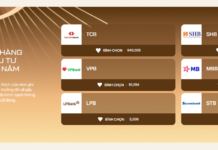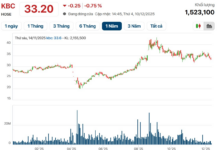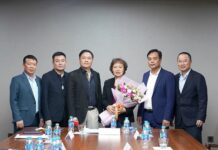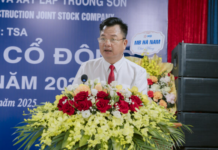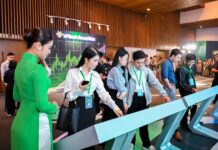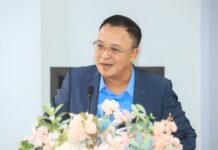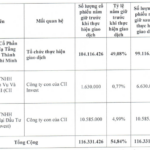
Prime Minister Pham Minh Chinh: Vietnam has strategic advantages and is determined to develop the semiconductor industry – Photo: VGP/Nhat Bac
On the morning of December 14, at the Government Office, Prime Minister Pham Minh Chinh, Head of the National Directive Committee for Semiconductor Industry Development, chaired the Committee’s first meeting.
Also present were Politburo member, Permanent Deputy Prime Minister Nguyen Hoa Binh; Central Committee member, Deputy Prime Minister, Minister of Foreign Affairs Bui Thanh Son; Central Committee members, leaders of ministries, branches, localities, some high-tech parks, educational institutions, and related business associations.
The reports and opinions at the meeting assessed that, in the past time, Vietnam has emerged as an attractive destination for investors in the semiconductor industry. In the semiconductor industry value chain, Vietnam is currently involved in the following stages: design, testing, chip packaging, equipment manufacturing, and material production related to semiconductors, but there is no chip manufacturing plant yet.
Currently, Vietnam has more than 50 microchip design enterprises with an estimated workforce of more than 6,000 engineers, 7 factories in the packaging and testing stage, with about 6,000 engineers and more than 10,000 technicians; enterprises in the production of equipment and materials for the semiconductor industry have also started operating. Vietnam currently has 174 FDI projects in the semiconductor field with a total registered capital of nearly 11.6 billion USD.
The delegates evaluated that these results demonstrate the efforts and drastic actions of the leaders at all levels, especially the Government, the Prime Minister, the ministries, branches, localities, educational institutions, and the business community in the development of the semiconductor industry…

Prime Minister Pham Minh Chinh, Head of the National Directive Committee for Semiconductor Industry Development, chaired the Committee’s first meeting – Photo: VGP/Nhat Bac
Developing a creative economy to create a new productive force
Concluding the meeting, Prime Minister Pham Minh Chinh assigned the Government Office, the Ministry of Planning and Investment – the standing agency of the Directive Committee, to thoroughly absorb the reasonable opinions of the members of the Directive Committee and delegates, and soon complete and issue the Concluding Notice of the meeting to unify the implementation.
Emphasizing some additional contents, analyzing the context, situation, and requirements for the development of the semiconductor industry, the Prime Minister clarified that developing the semiconductor industry is an objective requirement, a strategic choice, and a top priority.
In the next phase, we must achieve two 100-year goals (by 2030, the 100th anniversary of the Party’s foundation, and by 2045, the 100th anniversary of the country’s establishment), which requires breakthroughs and breakthroughs, especially in economic growth.
According to the Prime Minister, to promote growth, along with renewing traditional growth drivers such as investment, exports, and consumption, it is necessary to promote new growth drivers such as digital transformation, green transformation, circular economy, smart economy, knowledge economy, sharing economy, and night-time economy; especially in the fields of semiconductors, artificial intelligence, Internet of Things, and cloud computing, developing a creative economy to create a new productive force, with the spirit of “catching up, going together, and surpassing”.
Vietnam has strategic advantages in developing the semiconductor industry with the second-largest rare earth reserves in the world, a very favorable geographical location (located in the center of the region, accounting for up to 70% of the production volume of the global semiconductor industry), abundant human resources and great potential (one of the 16 most populous countries in the world with a large proportion of young people, ranked 44th out of 133 economies in innovation).
Regarding the guidelines and policies, what Vietnam has done and is doing, the Prime Minister informed that the Party has identified to continue to develop comprehensively human resources, science, technology, and innovation. Resolution No. 52-NQ/TW dated September 27, 2019 of the Politburo on a number of guidelines and policies to actively participate in the Fourth Industrial Revolution also identified the goal of rapid and sustainable development based on science, technology, innovation, and high-quality human resources.
The Prime Minister has established the Directive Committee; promulgated the Program for Human Resource Development in the Semiconductor Industry towards 2030, with a vision to 2050; the Strategy for Developing the Vietnamese Semiconductor Industry towards 2030 and a vision towards 2050; Directive No. 43/CT-TTg on promoting human resource training for the semiconductor industry and some core digital technology industries.
Along with that are mechanisms and policies to promote the semiconductor industry in the Law on the Capital City, Resolutions of the National Assembly on piloting some special mechanisms and policies for the development of some cities such as Ho Chi Minh City and Da Nang.
In the coming time, continue to break through in mechanisms and policies such as: Establishing an Investment Support Fund; proposing mechanisms and policies in the process of building legal documents: Law on Investment, Law on Corporate Income Tax, Fund for Science and Technology Development of enterprises, policies on personal income tax incentives…
In terms of infrastructure, the National Innovation Center (NIC) has been established as a public non-business unit in the field of economic affairs, along with high-tech parks in Ho Chi Minh City, Hoa Lac, and Da Nang, as well as many standard industrial parks, which are potential destinations in the process of transferring the semiconductor production chain and attracting FDI capital from large semiconductor technology corporations in the world such as: Amkor, Samsung, Hana Micron, Foxconn, LAM Research, Coherent, Intel.
Vietnam has many good information technology enterprises and investors such as Viettel, FPT, Phenikaa, which are implementing a development strategy and promoting specific projects in the semiconductor field; there are also potential startups in semiconductors such as Infrasen, VnChip, Hyphen Deux.
In terms of international cooperation, a Memorandum of Understanding on cooperation between Vietnam and the US has been signed, as well as the implementation of cooperation programs within the framework of the Innovation and Technology Support Fund (ITSI) on developing the ecosystem and human resources for the semiconductor industry.
Vietnam has proactively organized and connected investment and business through diverse activities such as the Vietnam Semiconductor Industry Exhibition; inviting and welcoming large technology corporations in the world such as NVIDIA, Samsung, Qualcomm, LAM Research, Marvell, Qorvo to explore the investment environment, towards expanding production and business and building bases in Vietnam.
Vietnam is strengthening international cooperation and establishing semiconductor cooperation frameworks with partners such as Korea, Japan, India…

Minister of Planning and Investment Nguyen Chi Dung, Standing Vice Chairman of the Directive Committee, presented a report at the meeting – Photo: VGP/Nhat Bac
Regarding difficulties and challenges, the Prime Minister said that the capital investment demand for the semiconductor sector is very large, but the specific incentive mechanisms to support investment and encourage all organizations and individuals to participate in this field have not kept up with practical requirements. Limitations in infrastructure for research and development, training, and incubation, as well as for production and business; Vietnam’s power supply is not guaranteed in some places and at some times. Limitations in accessing advanced technology and a shortage of high-quality human resources necessary for the development of this industry…
Promoting semiconductor diplomacy; technology transfer and mastery
In the coming time, the Prime Minister requested ministries, branches, and localities to perform the assigned tasks and functions, especially to implement the “Program for Human Resource Development in the Semiconductor Industry towards 2030, with a vision to 2050” and the “Strategy for Developing the Vietnamese Semiconductor Industry towards 2030”.
Regarding the viewpoint, the Prime Minister emphasized that “the Party has directed, the Government has agreed, the National Assembly has agreed, the people have supported, and the country is expecting, so we only discuss how to do it, not whether to do it or not”. There must be steps, a roadmap, a specific orientation, clear people, clear jobs, clear time, clear responsibilities, and clear results; promoting the responsibility of the head, high determination, great efforts, drastic actions, focusing on key issues; get the job done.
Along with that, strengthen decentralization and delegation of power in tandem with the allocation of resources, improve the capacity of subordinates, along with inspection, supervision, and control of power; in the process of implementation, there must be inspection, urging, and duplication of good models, and criticism of places that do not perform well. Strengthen communication, create consensus in the society about developing the semiconductor industry.

Minister of Information and Communications Nguyen Manh Hung speaks at the meeting – Photo: VGP/Nhat Bac
Regarding general and key tasks, the Prime Minister clarified that it is necessary to raise awareness with a strategic vision and breakthrough thinking about the position, role, and importance of the semiconductor, artificial intelligence, Internet of Things, and cloud computing fields; continue to improve the institutions to be open, with priorities for selected industries; develop synchronous infrastructure, especially transport infrastructure, digital infrastructure, innovation infrastructure, and electricity infrastructure… to reduce costs for businesses and investors, improve labor productivity, and enhance competitiveness; have mechanisms and policies to train and attract high-quality human resources; build a smart management and administration system; promote the early establishment of the Investment Support Fund; further promote research, technology transfer, and mastery; continue to promote semiconductor diplomacy, have appropriate and favorable visa policies; quickly develop design, testing, and chip packaging centers; participate in the global value chain of large corporations; develop this field based on Vietnam’s unique potential, outstanding opportunities, and competitive advantages in terms of geographical location, people, political stability, and harmonious and balanced development in relations with major countries.
The Prime Minister noted that developing human resources, institutions, and infrastructure for the semiconductor industry is a comprehensive strategy; it is necessary to implement and invest properly to match the strategic breakthrough. Promote administrative procedure reform, promptly direct the removal of difficulties, obstacles, and barriers in terms of administrative procedures related to production and business activities in the semiconductor field.
Along with that, promote public-private cooperation, domestic and international cooperation, and mobilize all resources for training and human resource development for the semiconductor industry. Cooperate in the spirit of “listening and understanding together”; “sharing the same vision and action”; “working, winning, enjoying, and developing together”; “harmonious interests, shared risks”.
Assigning specific solutions and tasks to ministries, branches, and localities, the Prime Minister requested the Ministry of Planning and Investment to continue to focus on promoting the implementation of tasks and solutions in the Program for Human Resource Development in the Semiconductor Industry towards 2030, with a vision to 2050. Soon complete and submit to the Government a Decree on the Investment Support Fund to encourage and attract investors from all over the world and support domestic enterprises.

Minister of Science and Technology Huynh Thanh Dat speaks at the meeting – Photo: VGP/Nhat Bac
The Ministry of Information and Communications continues to focus on and promote the implementation of tasks and solutions in the Strategy for Developing the Vietnamese Semiconductor Industry towards 2030 and a vision towards 2050, especially specific groups of tasks on developing specialized chips; develop the electronics industry.
The Ministry of Foreign Affairs shall build a “Project to promote international cooperation to mobilize resources for the development of Vietnam’s semiconductor and electronics industry”. Research, build, and submit to the competent authority for signing international cooperation agreements on semiconductors with some countries and leading economies in semiconductors; strengthen bilateral and multilateral cooperation in semiconductors.
Continue to promote the network of Vietnamese representative agencies abroad to promote international cooperation in the semiconductor and electronics industries, identify priority areas for cooperation with each partner. Continue to complete the database on overseas Vietnamese experts and intellectuals and educational institutions, universities abroad, and have a plan to approach, promote, and effectively connect with Vietnam.
The Ministry of Industry and Trade shall ensure the security of electricity supply, absolutely not let the shortage of electricity, meet the development requirements of the semiconductor industry. Chair and coordinate with the Ministry of Foreign Affairs to urge relevant agencies of the US to soon remove Vietnam from the lists of countries restricted from exporting high technology, thereby creating more favorable conditions for Vietnam to access advanced technologies of the US and promote cooperation between the two countries’ enterprises in high-tech fields, including semiconductors.
The Ministry of Education and Training shall continue to closely coordinate with the Ministry of Planning and Investment to implement the Program “Human Resource Development in the Semiconductor Industry towards 2030, with a vision to 2050”, including researching, proposing, and organizing the implementation of a model of linkage between the State, schools, and enterprises in training human resources for the semiconductor industry to ensure efficiency and quality.

The Prime Minister noted that developing human resources, institutions, and infrastructure for the semiconductor industry is a comprehensive strategy; it is necessary to implement and invest properly to match the strategic breakthrough – Photo: VGP/Nhat Bac
Urgently submit for promulgation the Scheme “Training human resources to serve the development of high technology in the period of 2025-2035 and orientation to 2045” to prepare STEM human resources (Science – Technology – Engineering – Mathematics) with professional and technical qualifications to meet the requirements of expanding investment in the development of high-tech fields, including the semiconductor industry, especially the team of talented human resources capable of participating deeply in the research and development stage in some key technology fields. Hasten to build and guide the implementation of microchip training standards.
The Ministry of Finance shall take the prime responsibility and closely coordinate with the Ministry of Planning and Investment and relevant agencies to research and propose mechanisms and policies on investment incentives, finance, and management and use of public assets to serve the training, research, and
“Urgent Action Required: Kick-starting the Expansion of the Hochiminh City – Trung Luong – My Thuan Expressway in Q2 2025”
The Government Office has issued Notification No. 558/TB-VPCP dated December 17, 2024, conveying the conclusions of Deputy Prime Minister Tran Hong Ha at the meeting on investing in the expansion of the Ho Chi Minh City – Trung Luong – My Thuan expressway project.
Commencing the Laos Cai-Hanoi-Haiphong Railway Project in 2025
The Ministry of Transport has outlined an ambitious investment plan for 2025, with a projected investment and disbursement of 87 trillion VND. A key highlight of this plan is the proposed construction of a new railway line connecting Lao Cai, Hanoi, and Haiphong, boasting a total investment of around 8.37 billion USD.
The Most Populous Province in Vietnam to Get a Stadium as Beautiful as Old Trafford
The local government has ambitious plans for the stadium in Thanh Hoa. In response to concerns about the stadium’s deterioration, the Chairman of the Provincial People’s Committee revealed that they have designed a new stadium that rivals the likes of Old Trafford.










